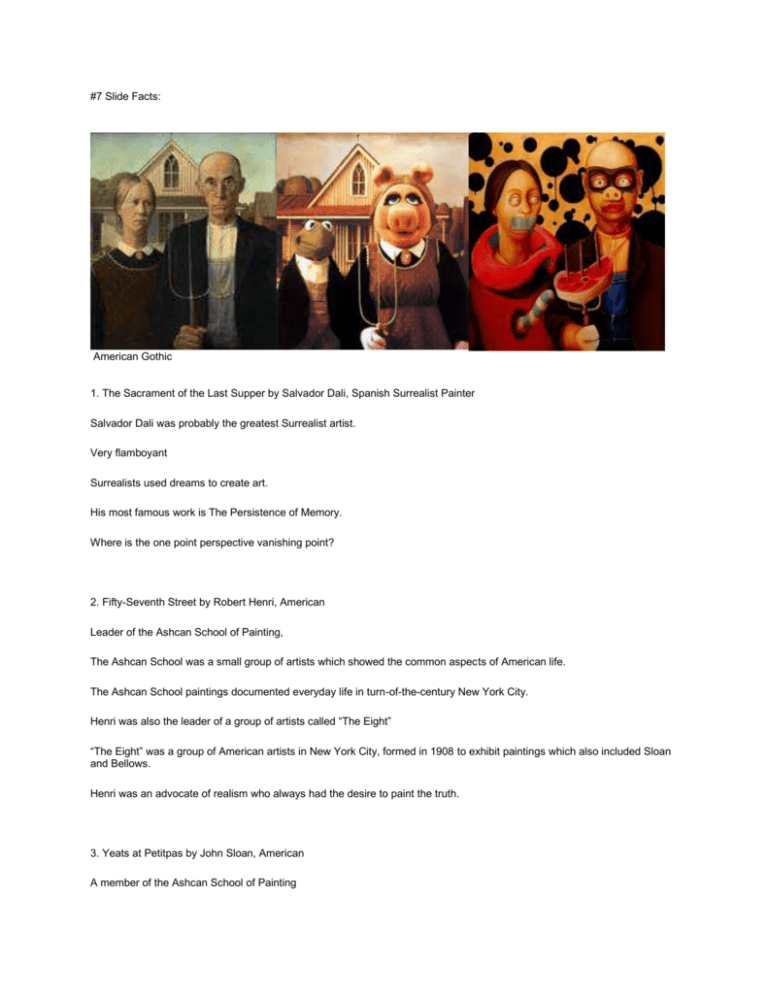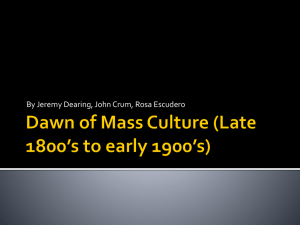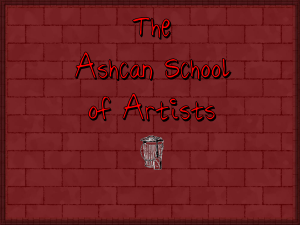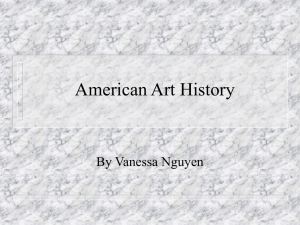#7 Slide Facts: American Gothic 1. The Sacrament of the Last
advertisement

#7 Slide Facts: American Gothic 1. The Sacrament of the Last Supper by Salvador Dali, Spanish Surrealist Painter Salvador Dali was probably the greatest Surrealist artist. Very flamboyant Surrealists used dreams to create art. His most famous work is The Persistence of Memory. Where is the one point perspective vanishing point? 2. Fifty-Seventh Street by Robert Henri, American Leader of the Ashcan School of Painting, The Ashcan School was a small group of artists which showed the common aspects of American life. The Ashcan School paintings documented everyday life in turn-of-the-century New York City. Henri was also the leader of a group of artists called “The Eight” “The Eight” was a group of American artists in New York City, formed in 1908 to exhibit paintings which also included Sloan and Bellows. Henri was an advocate of realism who always had the desire to paint the truth. 3. Yeats at Petitpas by John Sloan, American A member of the Ashcan School of Painting Also, a member of “the Eight” Ashcan work became better known when Sloan became Art Editor of the radical journal, The Masses. Yeats at Petitpas shows a group having fun at the boarding house where Sloan lived, which was run by the Petitpas sisters. Yeats was a famous poet. 4. The Soda Fountain by William Glackens, American American Ashcan School Painter, 1870-1938 The Ashcan School was a small group of artists who sought to document everyday life in turn-of-the-century New York City. The spirit of the Ashcan School was continued in the American Scene Painting of the 1920's and 1930's. Warm colors 5. The Cliff Dwellers by George Bellows, American American Ashcan School painter and member of ‘The Eight’ Bellows' urban New York scenes showed the crudity and chaos of working-class people and neighborhoods. Also satirized the upper classes; satire: to ridicule human vices The Anasazi Indians in the American West were cliff dwellers. 6. The Three Musicians by Picasso, Spanish Picasso and Braque created Cubism Picasso was inspired by Cezanne’s geometric shapes, when he created Cubism Do you see the dog in the art work? 7. I Saw the Figure 5 in Gold by Charles Demuth, American Style: Precisionism, 1920’s – 1930’s Demuth drew inspiration from geometric shapes of machines and modern technology. Precisionism (or Cubist Realism) represents an object in a realistic manner, but with an emphasis on its geometric form. An important part of American Modernism. It's style was inspired by the development of Cubism in Europe, and by the rapid growth of industrialization of North America in the wake of innovators such as Henry Ford. It's subject matter was inspired by a poem called The Great Figure. Precisionism gradually evolved towards Abstraction, and faded away as an important influence. 8. Nighthawks by Edward Hopper, American Edward Hopper (1882 –1967) is remembered for the solitude and loneliness of contemporary American life. He was a member of the Ashcan School of American art and ‘The Eight’. BUT he avoided being closely associated with either the Regionalist or Social Realist camps. He liked the contrast of strong lights against strong dark values/color. In terms of subject matter, he can be compared to his contemporary, Norman Rockwell, although: * Rockwell’s work rejoiced in the rich small-town imagery of America * But Hopper depicts the same subject matter showing loneliness and isolation. He used subject matter showing common features of American life — gas stations, motels, the railroad, or an empty street. The best known of these paintings, Nighthawks (1942), shows customers sitting at the counter of an all-night diner. The actual buildings were in Greenwich, Connecticut (might still be...don't know). 9. Cow’s Skull with Calico Roses by Georgia O’Keeffe, American (1887-1986) Abstract style O'Keeffe is one of the greatest artists of the 20th century, probably the most well known American female artist, and one of the most well known female artists in the world. Her work was first exhibited in 1916 at the gallery of Alfred Stieglitz, whom she later married in 1924. Meanwhile, O’Keeffe briefly studied in South Carolina, which began her re-entry into painting. In 1929, O'Keeffe vacationed in New Mexico, eventually moving there after Stieglitz died. Immaculate, sculptural, organic forms painted in strong, clear colors predominate in her works. Living much of her adult life in New Mexico, O'Keeffe painted Southwestern motifs such as bleached animal bones, barren, rolling hills, clouds and open skies, and desert blooms. Eventually, O'Keeffe's vision deteriorated dramatically, and she withdrew from artistic life. It was not until 1973, after meeting Juan Hamilton, a young ceramic artist, that she returned to working. With his encouragement and assistance, she resumed painting and sculpting until her death in 1986. 10. American Gothic by Grant Wood, American Regionalist style that focused on realistic scenes of rural America Most famous painting is American Gothic When he studied Renaissance artists in Europe, their stern faces reminded him of the Midwestern people he knew back home; so, he returned to Iowa. The house is real and is in Eldon, Iowa. He used his dentist and niece as models for this painting. The style of the window in the background is of the Gothic Architectural Style. American Gothic became famous because of: a. the 1929 stock market collapse which led to the Great Depression b. traditional values and simpler times of rural American seen in Wood’s painting comforted a country going through fearful and uncertain times. American Gothic can be seen as a. a satire on small-town stereotypes b. symbol of American morality and courage







